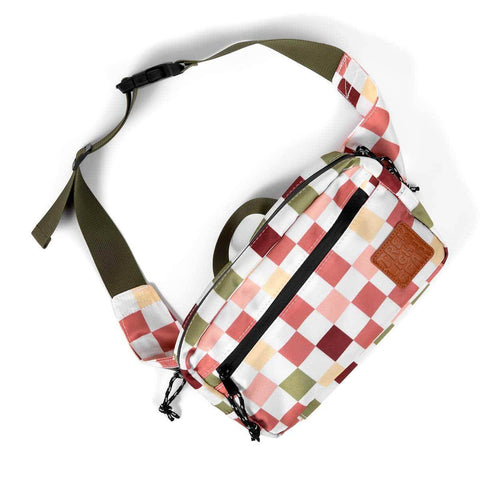No pasa un día sin que algún cliente nos haga una pregunta que tiene curiosidad sobre cómo configurar mejor su hamaca .
Ya sea que se trate de instalarlo en un balcón, en un dormitorio, entre dos Jeeps o simplemente en el patio trasero, las situaciones siempre son diferentes, pero las preguntas a menudo son las mismas:
¿A qué distancia deben estar los puntos de fijación?
¿Qué altura deben tener para asegurarse de que la hamaca no toque el suelo?
¿__ pies de distancia es demasiado corto/largo para colgar la hamaca?
Si has leído nuestra publicación sobre el ángulo de la hamaca (parte de nuestra Guía para dormir en una hamaca ), sabes que debes colgar tu hamaca con barra sin separador con una curva agradable y suelta para que puedas acostarte en un ángulo sobre ella y quedar plano .

[NOTA: Si su hamaca tiene una barra separadora de metal o madera en cada extremo, entonces esta guía no se aplicará a su hamaca. Para descubrir por qué probablemente debería cambiar a una nueva hamaca, consulte nuestra publicación sobre Cómo le han lavado el cerebro con las hamacas .]
Al instalar la hamaca, la curvatura (también conocida como comba) se determinará por la distancia entre los extremos. Esta distancia se puede medir fácilmente midiendo el espacio vacío entre cada extremo. Esta distancia se conoce comúnmente como longitud de la cumbrera de la hamaca .
Probablemente ya estés pensando: "¡Vaya, colgar una hamaca implica mucho más de lo que pensaba!". Pues sí y no.
Colgar tu hamaca Trek Light entre dos puntos puede y debe ser tan sencillo como calcularla a ojo una vez que te acostumbres (y siempre puedes hacer ajustes fáciles con nuestro kit de cuerda Go Anywhere ). ¡Una cinta métrica definitivamente no forma parte de nuestro kit de mochilero!
Pero conocer los factores involucrados puede ser extremadamente útil para comprender cómo funciona todo. Y, si buscas colgar una hamaca de forma permanente (como instalar cáncamos en la pared o postes en el jardín), seguir las instrucciones con las medidas es sin duda la mejor opción para asegurarte de que la hamaca quede exactamente como quieres.
Para desglosarlo, al colgar una hamaca se trata de una combinación de cada uno de estos factores para determinar el resultado final:
- Distancia entre los dos objetos
- Altura de los puntos de fijación (donde se coloca la cuerda, las correas o los cáncamos)
- Longitud de la cresta de la hamaca
- A qué altura del suelo se encuentra la hamaca (piense en ello como la altura de una silla)

Otro factor de seguridad importante a tener en cuenta (especialmente al fijarlo a una pared o techo) es la cantidad de fuerza que se aplica a los puntos de anclaje y suspensión cuando estás acostado en la hamaca.
La fuerza aplicada no depende solo del peso de la hamaca, como muchos creen. En realidad, es una combinación de factores, como el peso y el ángulo de suspensión (el ángulo entre la cuerda y el árbol, como se muestra en la imagen de la derecha).
En resumen, cuanto más se tensa la hamaca, mayor será la fuerza ejercida sobre los puntos de suspensión y anclaje (¡otra razón para no aflojarla!) . Un ángulo de aproximadamente 30 grados se considera ideal.
Pero no te preocupes, tampoco necesitas un transportador en tu mochila; el ángulo siempre será correcto si sigues las pautas a continuación. La tensión o la holgura con la que debes colgar la hamaca depende de tus preferencias, pero definitivamente hay un punto ideal que crea la curva ideal.
En nuestras hamacas individuales y dobles, la longitud de la cumbrera es de aproximadamente 2,7 m (108 pulgadas) para lograr una curvatura ideal. En nuestra hamaca compacta , que es 30 cm más corta, la longitud es de aproximadamente 2,4 m (96 pulgadas) .
Entonces, ¿cómo tomas todas estas medidas variables y descubres cómo colgar tu hamaca?
Por suerte para todos los que usamos hamacas, hay un héroe en la comunidad de hamacas llamado Derek Hansen, quien creó The Hammock Hang Calculator .
Derek es un entusiasta de las hamacas, autor e ilustrador talentoso que ha desglosado la física de colgar una hamaca y ha diseñado una calculadora fácil de usar y comprender.
Usando la calculadora para colgar hamacas
Solo tienes que introducir algunos de tus factores conocidos (o deseados) y la calculadora se encargará del resto. Incluso se abre con varias opciones predeterminadas que funcionan a la perfección con tu hamaca Trek Light : la longitud de la cresta ya está configurada en 274 cm y la altura del asiento en 45 cm (la altura promedio de la silla para la mayoría).
Si la longitud de la cresta y la altura del asiento son lo que desea, todo lo que necesita hacer es ingresar la distancia entre sus puntos y su peso si le preocupa (o siente curiosidad) sobre la cantidad de fuerza que se aplica, ¡y estará listo para comenzar!
La calculadora de suspensión de hamaca le mostrará a qué altura debe colocar los puntos de suspensión (cuerda, correas, cáncamos, etc.) para obtener una suspensión perfecta en todo momento .
Muchas gracias a Derek por crear una herramienta tan increíble para los amantes de las hamacas. Recuerda que todas estas cifras son aproximadas y que colgar tu hamaca no tiene por qué ser una ciencia exacta; se trata de encontrar la forma en que te resulte cómodo.
Como se indica en la exención de responsabilidad de la página, tenga en cuenta que la calculadora está diseñada solo para fines de estimación y entretenimiento, y lo mismo aplica al contenido de esta guía. Siempre consulte a un profesional al colgar su hamaca en interiores, asegúrese de que cualquier objeto del que la cuelgue sea lo suficientemente resistente como para soportar su peso y revise bien todo el equipo.
Ni Derek ni Trek Light se hacen responsables de daños o lesiones que resulten de colgar su hamaca de forma incorrecta, de un objeto inseguro o de manera insegura .
¡El mejor hang!
Pronto les contaremos más sobre Derek Hansen en el blog, ya que Derek acaba de publicar un libro increíble sobre acampada en hamaca titulado "The Ultimate Hang: An Illustrated Guide To Hammock Camping" . Lo vendemos en nuestra tienda, así que pueden comprarlo de inmediato y lo recomiendo ampliamente a quienes quieran aprender más sobre el mundo de la acampada en hamaca.
Derek utiliza más de 200 ilustraciones y una gran cantidad de conocimientos para explicar todo lo que necesita saber sobre temas como mantenerse seco, mantenerse abrigado y, por supuesto, cómo montar su hamaca correctamente.
Espero que esta guía, junto con la Calculadora de suspensión de hamaca , haya sido increíblemente útil para ayudarlo a determinar cómo colgar su hamaca Trek Light.
Si tienes alguna pregunta sobre cómo colgar tu hamaca o sientes que nos hemos olvidado de algo, ¡publica tu pregunta en los comentarios a continuación!
(PD: ¡También puedes descargar una versión móvil de la Calculadora de suspensión de hamacas para tu iPhone en la tienda Apple!)










Comentarios (73)
I have been sleeping poorly for some years. My back is not as good as it once was and I have a fairly good mattress. I’ve tried several different pillows: memory foam, contoured, etc. but still don’t get great rest, so I started thinking about a hammock. I didn’t know if people actually used them for normal everyday sleeping and I didn’t want to be a member of the weirdo club, so I searched. I was encouraged to find that many people do recommend it and even say it’s good for the back.
So I plunged into buying one after doing some research on models, especially since they are so much less expensive than mattresses. I had to get one with a stand so I did some research and decided on a “Vivere Double Hammock with Space Saving Steel Stand”. It is 100% cotton and the hammock bed is 63 × 94-Inch, with a total length of 130-Inches. I figured I’d better go for a double since I’m 6’6".
I tried it the first night and made it through about 4 hours before I crawled out and back onto my bed. I was restless much of the night and my back had started feeling tight. I often sleep on my stomach so that was definitely out with the hammock. I sometime sleep on my back or sides as well and figured I turned because the bed wasn’t comfortable. I figured I could make it in the hammock without needing to be on my stomach. That first night, I had tried putting in a blanket first, thinking it would soften the material and I could cover with it. I found this very difficult to do because of the curling and wondered if that had contributed to the poor rest.
I tried it the second night but just laid on the hammock fabric and draped the blanket over the hammock, much easier to achieve. I also use a pillow this time. I made it a little over three hours before going back to my bed. Again, my back was not feeling good. I did notice then that the pressure from my mattress seemed very intense for awhile.
So I started wondering about the adjustments on the hammock. I figured the tautness of the hammock must play a big part in this. I wasn’t sure if both ends were supposed to be the same height or one should be lower. This Vivere frame has a wide U-shaped bar on the top of the uprights were the hammock ropes rest on and a hook on the pipe to secure the loop. This is adjustable with six holes that you change where the hook goes. I think I had it on the third hole down previously. Then I read you don’t want the hammock strung too tightly, so I lowered it to the second holes. The very top hole is useless because you drag the floor (and the bar) if you get in (I’m about 220). Using the second holes places me about 3 inches from the frame bar beneath me when I’m lying down so I can’t make it any less taut than this.
If you, oh guru of the hammock, can give me any advice on this, that would be great. Am I just too tall for this or am I doing something else wrong? I do lay at an angle in the hammock.
Hi all. Hammock newbie. Have a stand which I would like to use but not sure how to calculate for a hammock. Between hooks 114". Height of hooks 41". Any chance of getting something to fit this and let my 6’ 215 lb. body fit in? Would appreciate any help. Thanks
Hi Scott – I haven’t tried every hammock stand out there so it’s difficult to give you and accurate answer – the calculator can be difficult to translate to a hammock stand since every one is designed a bit differently. My concern with the stand you referenced would be the height of the hooks. The height of the hammock stand we currently sell is 54" and the length is 124" at its shortest. I’d be worried that you’d sink too low in the stand you’ve got so you’d be on the ground. Some hammock stands aren’t as tall because they’re designed with spreader bar hammocks in mind – those hammocks are meant to be pulled tight with little sag, unlike a hammock like ours (and what the hang calculator is geared towards). I wish I could give you a better answer, if you order one of our hammocks off of Amazon you can always take advantage of their free shipping and easy returns to give it a try!
Thanks Seth. The stand was a gift and in reading your blogs I was trying to go away from the spreader bar. But it sounds like my stand specs won’t work with your style. I do appreciate the quick follow up!
The calculator is amazing! Now I know since my straps are only 54" long, not including the diameter of the tree, most optimal hang spaces is right around 10-12ft for me (~double my arm span) which is pretty easy to measure. I also should hang my straps at about 5’ or my shoulder height. I’ve been hanging them much higher (overhead) which reduces my ridgeline length and increases my suspension length. You should only set your hang point higher to reduce cord tension which might be a factor when trying to sleep two in the same hammock.
What’s the minimum distance needed between hooks for a single
Typically you’ll want ~8.5ft as a minimum (either for our Single or Double). You can definitely use the hammock comfortably with less span but I’ve found that to be a pretty ideal minimum if you plan on spending a good amount of time in the hammock, using it for sleeping, etc.
Thank you Seth, I am wondering about the height of the tie in. I have two posts 10’ apart built under an ivy covered gazebo type thing. The hooks are 48" high. I built it to fit a single spreader bar hammock a long time ago. Will it sag to the deck?
That should work. If you plug those numbers into the calculator it recommends a height of ~52in. to get the hammock to hang at a ‘seat height’ of 18", which is ideal for most people. Working backwards you wind up with a seat height of 13-14 inches when your anchor points are at 48" high. That’s a bit lower than your average chair but it should still keep you high enough off the ground (provided your suspension isn’t stretching further when you get in).
Wow, thanks for the quick answer. Perfect enough. Even my little grandkids will be able to get in and out